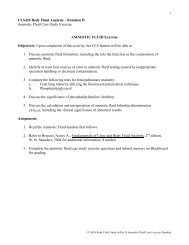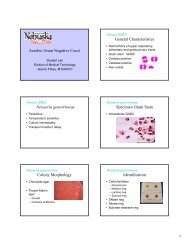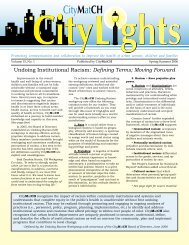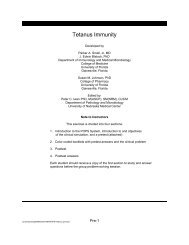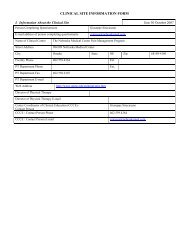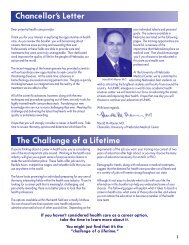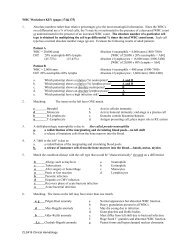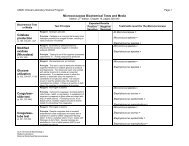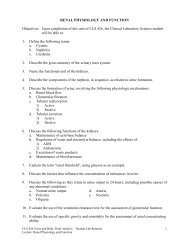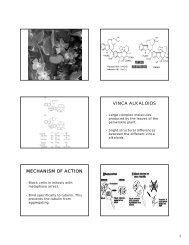CLS 422 Clinical Immunohematology I Take Home Quiz Day Two ...
CLS 422 Clinical Immunohematology I Take Home Quiz Day Two ...
CLS 422 Clinical Immunohematology I Take Home Quiz Day Two ...
Create successful ePaper yourself
Turn your PDF publications into a flip-book with our unique Google optimized e-Paper software.
20. The main difference between the direct antiglobulin test (DAT) and the indirect<br />
antiglobulin test (IAT) is:<br />
a. Sensitization takes place in the test system in the indirect antiglobulin test<br />
and in the body in the DAT.<br />
b. Specimen for the DAT is either the patient’s cells or serum whereas the<br />
IAT only uses the patient’s serum.<br />
c. The IAT detects only IgG antibodies whereas the DAT detects IgG and<br />
complement.<br />
d. Use of enhancement reagents is required in the IAT but not in the DAT.<br />
21. Which of the following specimens is the best to use for a direct antiglobulin test?<br />
a. Clot tube with gel separator<br />
b. Clot tube, no gel, stored overnight at 1-6C<br />
c. EDTA<br />
d. Any plasma specimen will work equally well.<br />
22. When investigating a positive DAT, it is important to get an accurate patient<br />
history which includes: (More than one correct answer)<br />
a. ABO & Rh<br />
b. Diagnosis<br />
c. Medications<br />
d. Transfusions<br />
23. In a hemolytic transfusion reaction, the patient has:<br />
a. An allergy to a protein in the donor plasma.<br />
b. Bacteria in the blood stream, due to contamination of donor blood.<br />
c. An antibody directed against antigens on the donor’s leukocytes.<br />
d. An antibody directed against antigens on the donor’s red blood cells.<br />
24. In Hemolytic Disease of the Fetus and Newborn (HDFN), a positive DAT<br />
indicates that the:<br />
a. Infant’s RBCs are coated with maternal antibody.<br />
b. Mother’s RBCs are coated with fetal antibody.<br />
c. Infant’s RBCs are coated with paternal antibody.<br />
d. Mother’s RBCs are in the infant’s circulation.<br />
<strong>CLS</strong> <strong>422</strong> <strong>Clinical</strong> <strong>Immunohematology</strong> I Page 5 of 6<br />
Student Lab <strong>Day</strong> <strong>Two</strong> <strong>Take</strong> <strong>Home</strong> <strong>Quiz</strong>




